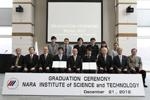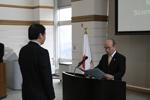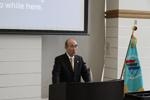2012/12/25
On Friday, December 21, 2012, a graduation ceremony was held in the Training Hall in the Center for Frontier Science and Technology.
President Isogai presented degrees to each graduate and gave the congratulatory speech to the 4 graduates.
After the ceremony, the commemorative photograph was taken and the graduates enjoyed the graduation ceremony with the president, executive directors and their supervising professors.
*Number of Graduates in December
【Doctoral Graduates】
Biological Sciences 3
Materials Science 1
【Congratulatory Remarks to Graduating Students by President ISOGAI】
On behalf of all staff and faculty at NAIST, I extend my heartfelt congratulations to all the students receiving their doctoral degrees here today, the third graduation ceremony of the 2012 school year. The diplomas we will be handing you are evidence that all of you have the ability and knowledge befitting a doctoral degree holder. As NAIST President, I would like to recognize your vast efforts leading up to this graduation ceremony.
Including the graduates in front of me today, NAIST has conferred 5560 master's and 1100 doctoral degrees since its establishment. We look forward to your future accomplishments in various fields, as an important member of our distinguished, globally-active alumni.
As all of you know, NAIST is a relatively new university, having just celebrated its 20th anniversary last year. During these past two decades, the faculty, staff and students at NAIST have strived diligently. As a result of their efforts, NAIST has developed and contributed considerable results to both education and scientific research, leading to our current high evaluation and recognition. In order for NAIST to carve out another historic 20 years, the faculty, staff, and students will continue their efforts, which are now focused on raising NAIST's international recognition. Amidst these efforts here on campus, NAIST Honorary Professor Shinya Yamanaka received the Nobel Prize in Physiology or Medicine, for which he attended the award ceremony in Stockholm, Sweden on December 10th.The news of Professor Yamanaka's Nobel Prize brings hope to Japan, which has recently been facing societal and economical difficulties. I believe that the influence on our children, the future of Japan, will be especially far reaching. Additionally, both Professor Yamanaka and former NAIST president Professor Yasuyuki Yamada were awarded this year's Order of Culture in November. Professor Yamada was the president of NAIST when Professor Yamanaka started working here, so these professors were not only both directly related to NAIST, but they also had a working relationship while here. In the media, they were introduced as "the first ever mentor and mentee from different fields to receive the award." These awards are representative of the fruits of NAIST's 20-year history and clearly show the significance of our school's establishment. For both professors and for NAIST, these awards are exceedingly auspicious. In celebrating these awards, I believe that NAIST's societal recognition will be further extended. I encourage you to tell others, "I attended NAIST, the university that helped produce a Nobel Prize winner." I also hope that you take pride in graduating from a university of such prominence.
Today, in bidding you farewell, I would like to talk about Professor Yamanaka. Last year, Professor Yamanaka gave a special lecture at NAIST's 20th anniversary ceremony. In this lecture he talked about 'VW', not Volkswagen, but the phrase he learned in America, "Vision and Work hard." This means have your own vision and work hard to achieve it.
When Professor Yamanaka came to NAIST, he thought very deeply about what he wanted to research. He chose to research the creation of a pluripotent cell, similar to ES cells, from body tissue--a procedure which no other researcher had undertaken. The professor and the students that were drawn to his interesting aim performed an enormous amount of research, and succeeded in the creation of this cell in a relatively short period. He named this cell the "iPS cell." Professor Yamanaka came to NAIST in 1999, the publication of his research which led to the Nobel Prize was made public in 2006 and his receiving of the Nobel Prize has come now in 2012. From this timeframe we can easily see the swift progress and wide impact of Professor Yamanaka's research. Now, the word iPS has spread around the world and has become a societal phenomenon.
I would like to add the words 'think deeply' to Professor Yamanaka's VW (vision and work hard). As scientists or engineers, sometime in the future there will come a time when you will have to think for yourself and decide what you should and what you will do. At that moment, no one will be guiding your work. You alone will be responsible for deciding what your path should be. In other words, in order to have your own vision you need to think deeply and you need the ability to think deeply. Furthermore, you must be able to clearly understand your focus and your goals. From Professor Yamanaka's words, "I want to do clinical research with iPS cells," I believe his vision was to be a doctor. Even while performing basic research, I feel that the professor's focus and conviction was the final goal of helping patients as a doctor. I hope that you think often about yourself and your position in society, and that you have the training and the essential knowledge necessary to think thoroughly when the time comes to follow your vision. Of course, conviction as to what you are and what you do is also necessary.
In the essay "Ekiden to iPS Cells," written in 2009 when Professor Yamanaka received the Lasker Award, he wrote that his research was made possible by Professor Gurdon's research accomplishments and that he and others were carrying a baton, each in turn, toward a common goal in a long-distance relay (ekiden). For this most part, this kind of collaboration and cooperation is what leads to extraordinary results in modern science and technology. With this in mind, the ability to organize and lead is necessary to achieve these results. I believe this involves not only research ability, but also personal integrity. I believe Professor Yamanaka has this integrity, and at every opportunity to speak he expresses his appreciation towards previous and present researchers and collaborators. The professor's sincerity is truly amazing, and I believe that as a person and a researcher he may is a worthy role model to you all.
Another lesson we may learn from Professor Yamanaka's work can be found in the story of his trusted assistant, Dr. Kazutoshi Takahashi, who is still working with the professor at Kyoto University. Dr. Takahashi studied chemistry as an undergraduate and started studying biological science only after he came to NAIST. Through his diligent work and determination after coming to NAIST, he has become a world-renowned young researcher. In choosing to change his environment, Dr. Takahashi chose to stimulate himself and, as a result, he grew as a researcher. In a way, his meeting with Professor Yamanaka determined his future as a researcher. I believe this kind of chance is an important characteristic of NAIST's educational system. I often hear about the problems of isolation in Japanese university education and how Japanese students don't want to go abroad. However, if students choose to study in a constant, unchanging environment, prominent researchers like Professor Yamanaka and Dr. Kazutoshi Takahashi, who undertake new challenges, will not be produced.
All of you today left your undergraduate schools and came to study at NAIST. I am sure you have had many challenges here. Now you are finishing your studies here at NAIST, but this is not the end of your educational journey. Please continue to study hard, think deeply, and keep aiming high. Do not be afraid to change your environment, and be diligent in what you undertake to continue improving yourself. If you do all of these things, I am confident you will have a bright future. If you have had an encounter like Dr. Takahashi's at NAIST, please value that relationship. This kind of encounter and relationship may greatly impact your life. As I have always said, our graduates' work and activities after they leave NAIST forges our school's history and shapes its future. We at NAIST all look forward to your future and congratulate you on your graduation today.
Akira Isogai
Nara Institute of Science and Technology President, December 21, 2012







